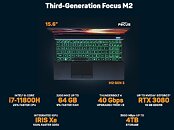- Joined
- Oct 9, 2007
- Messages
- 47,895 (7.38/day)
- Location
- Dublin, Ireland
| System Name | RBMK-1000 |
|---|---|
| Processor | AMD Ryzen 7 5700G |
| Motherboard | Gigabyte B550 AORUS Elite V2 |
| Cooling | DeepCool Gammax L240 V2 |
| Memory | 2x 16GB DDR4-3200 |
| Video Card(s) | Galax RTX 4070 Ti EX |
| Storage | Samsung 990 1TB |
| Display(s) | BenQ 1440p 60 Hz 27-inch |
| Case | Corsair Carbide 100R |
| Audio Device(s) | ASUS SupremeFX S1220A |
| Power Supply | Cooler Master MWE Gold 650W |
| Mouse | ASUS ROG Strix Impact |
| Keyboard | Gamdias Hermes E2 |
| Software | Windows 11 Pro |
The Kubuntu Focus Team announces the availability of the third-generation M2 Linux mobile workstation with multiple performance enhancements. RTX 3080 and RTX 3070 models are in stock now. RTX 3060 models can be reserved now and ship in the first week of November. The thin-and-light M2 laptop is a superb choice for anyone looking for the best out-of-the-box Linux experience with the most powerful mobile hardware. Customers include ML scientists, developers, and creators. Improvements to the third generation include: 
The GPU choices include the NVIDIA RTX 3060, 3070, or 3080 with up to 16 GB of VRAM. Customers can skip the dongles with plenty of high-speed ports and the ability to drive 3 external 4K displays with standard cables. Learn more on the product page.
View at TechPowerUp Main Site
- Cooler and faster Intel 11th generation Core i7-11800H. Geekbench scores improve 19 and 29%.
- Double the iGPU performance with Intel Iris Xe 32EU Graphics.
- Increased RAM speed from 2933 to 3200 MHz, up to 64 GB dual-channel.
- BIOS switchable USB-C GPU output.
- Upgrade from Thunderbolt 3 to version 4.

The GPU choices include the NVIDIA RTX 3060, 3070, or 3080 with up to 16 GB of VRAM. Customers can skip the dongles with plenty of high-speed ports and the ability to drive 3 external 4K displays with standard cables. Learn more on the product page.
View at TechPowerUp Main Site


 ,
,
